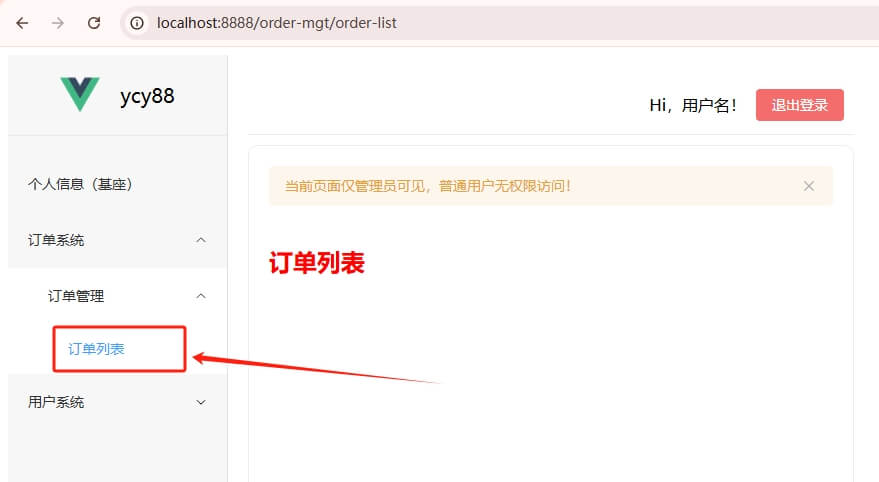集成方案-路由管理-子应用上报
1. 子应用路由上报机制
实现方案:
子应用:运行时上报路由
利用 Qiankun 的生命周期钩子,将路由数据动态上报。javascriptconst routes = [ { path: "/dashboard", title: "仪表盘" }, { path: "/list", title: "订单列表" }, ]; export async function mount(props) { if (props.onRouteReady) { props.onRouteReady(routes); } }主应用:动态注册路由
主应用在收到路由数据后,动态更新菜单。javascriptregisterMicroApps([ { name: "vue-order", entry: "//localhost:8081", container: "#vue-order", activeRule: "/vue-order", props: { onRouteReady: (routes) => { menus.push( ...routes.map((route) => ({ path: `/vue-order${route.path}`, title: route.title, })) ); }, }, }, ]);
多个子应用时,registerMicroApps 无法动态加载子应用路由
存在的问题是:我没有访问某个子应用的话,它就完全不加载不激活,那我就无法拿到它的动态路由,也就无法将动态路由渲染到主应用中来。
此方式的代码片段
1)主应用:main.ts 文件(部分核心代码)
js
// 创建一个响应式的 menus
const stateMenu = reactive({
menus: [],
});
// 默认只加载一次
const isInit = {};
// 在主应用中注册子应用
registerMicroApps(
[
{
name: "userMgt", // 微应用的名称 要求唯一
entry: "//localhost:8081", // 通俗理解就是(微应用的访问地址)
container: "#Child-box", // 微应用挂载到主应用上的容器
activeRule: "/user-mgt", // 微应用激活条件
props: {
actions,
onRouteReady: (routes) => {
if (!isInit.userMgt) {
isInit.userMgt = true;
stateMenu.menus.push(...routes);
}
},
},
},
{
name: "orderMgt", // 微应用的名称 要求唯一
entry: "//localhost:8082", // 通俗理解就是(微应用的访问地址)
container: "#Child-box", // 微应用挂载到主应用上的容器
activeRule: "/order-mgt", // 微应用激活条件
props: {
actions,
onRouteReady: (routes) => {
if (!isInit.orderMgt) {
isInit.orderMgt = true;
stateMenu.menus.push(...routes);
}
},
},
},
],
{
beforeLoad: (app) => console.log("before load", app.name),
beforeMount: [(app) => console.log("before mount", app.name)],
}
);2)子应用 Order 系统
src/main.js:主要是将子应用的路由信息传递给主应用。
js
// 其他(略)
import { routesResult } from "./router/index";
export async function mount(props) {
if (props.onRouteReady) {
props.onRouteReady(routesResult);
}
render(props);
}
// 其他(略)src/router/index.js:格式化路由数据信息,并导出
js
// 其他(略)
import { extractNestedRoutes } from "../utils/tools";
const routes = [
{
path: "/",
name: "Home",
title: "订单系统",
alias: "/", // 根路径的别名,指向 /home
component: () => import("../views/Home.vue"),
redirect: "/order-mgt",
children: [
{
path: "/order-mgt",
name: "OrderMgt",
title: "订单管理",
component: () => import("@/views/order-mgt/index.vue"),
redirect: "/order-mgt/order-list", // 默认重定向到 /order-mgt/order-list
children: [
{
path: "order-list",
name: "OrderList",
title: "订单列表",
component: () => import("../views/order-mgt/OrderList.vue"),
},
],
},
],
},
];
export const routesResult = extractNestedRoutes(routes);
// 其他(略)src/utils/tools.js:提取嵌套路由数据信息
js
export const extractNestedRoutes = function (routes, basePath = "") {
return routes
.map((route) => {
// 如果 basePath 是根路径 `/`,那么直接使用子路由的 path,避免出现 `/order-mgt` 这样的路径
const fullPath = `${basePath === "/" ? "" : basePath}${
route.path.startsWith("/") ? route.path : `/${route.path}`
}`.replace(/\/\//g, "/");
// 初始化当前路由
const currentRoute = {
path: fullPath,
title: route.title || "", // 保留 title
children: [], // 初始化 children
};
// 如果有子路由,递归提取并嵌套
if (route.children) {
currentRoute.children = extractNestedRoutes(route.children, fullPath);
}
// 如果当前路由没有 title,但有子路由,移除 title
if (!route.title && currentRoute.children.length > 0) {
delete currentRoute.title;
}
// 删除空的 children 属性
if (currentRoute.children.length === 0) {
delete currentRoute.children;
}
return currentRoute;
})
.filter((route) => route.title || route.children); // 保留有 title 或有子路由的路由
};3)子应用 User 系统
与 Order 系统类似,这里不再赘述。唯一的区别就是路由菜单不同。
js
import { extractNestedRoutes } from "../utils/tools";
const routes = [
{
path: "/",
name: "home",
alias: "/", // 根路径的别名,指向 /home
title: "用户系统",
component: () => import("../views/Home.vue"),
redirect: "/user-mgt",
children: [
{
path: "/user-mgt",
name: "UserMgt",
title: "用户管理",
component: () => import("@/views/user-mgt/index.vue"),
redirect: "/user-mgt/user-list", // 默认重定向到 /user-mgt/user-list
children: [
{
path: "user-list",
name: "UserList",
title: "用户列表",
component: () => import("../views/user-mgt/UserList.vue"),
},
{
path: "user-roles",
name: "UserRoles",
title: "用户角色",
component: () => import("../views/user-mgt/UserRoles.vue"),
},
{
path: "user-permissions",
name: "UserPermissions",
title: "用户权限",
component: () => import("../views/user-mgt/UserPermissions.vue"),
},
],
},
],
},
];
export const routesResult = extractNestedRoutes(routes);
// 其他代码...1)默认不显示子路由,只有当路由匹配到时,才显示子路由。
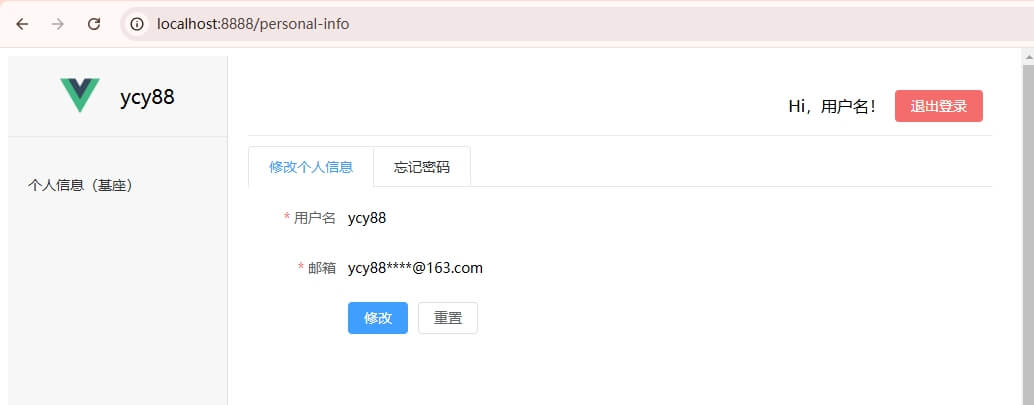
2)访问 OrderList 时,显示子路由。
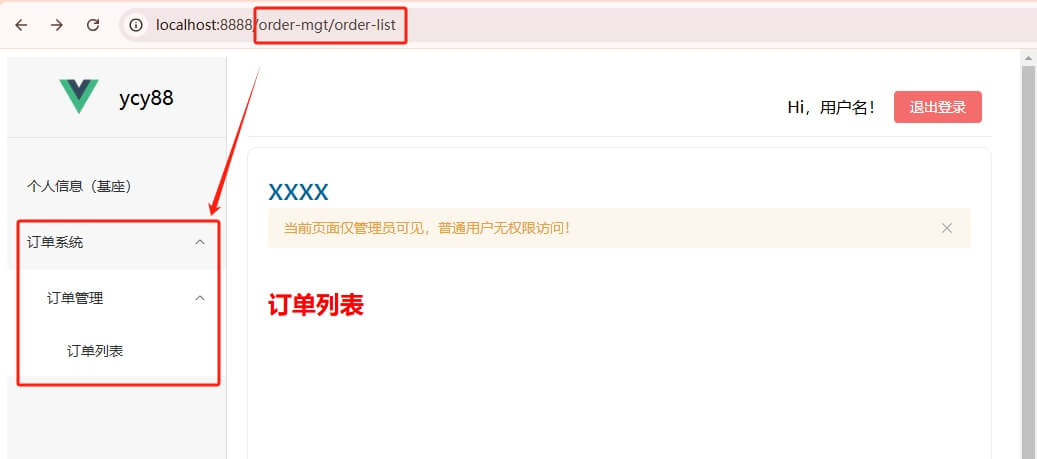
3)访问 UserList 时,显示子路由。
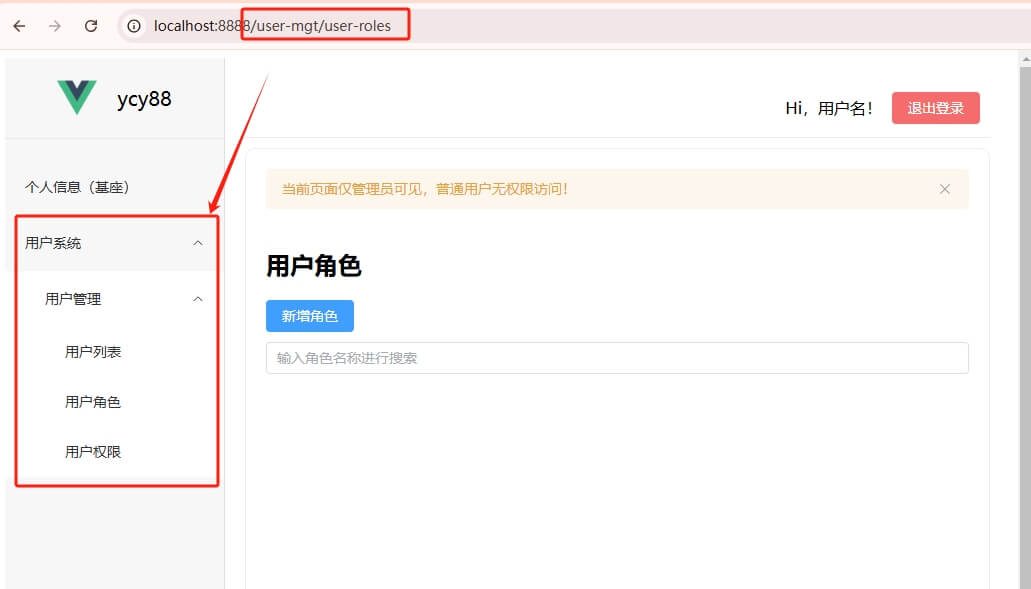
2. 必须加上【手动加载】功能
需要手动加载子应用,否则子应用无法显示。
提示
loadMicroApp里面的配置文件与registerMicroApps里面的配置文件一致。
js
// ========================= Start ========================================
// 直接调用 `loadMicroApp` 加载微应用(不激活)
loadMicroApp({
name: "userMgt", // 微应用的名称 要求唯一
entry: "//localhost:8081", // 通俗理解就是(微应用的访问地址)
container: "#Child-box", // 微应用挂载到主应用上的容器
activeRule: "/user-mgt", // 微应用激活条件
props: {
actions,
onRouteReady: (routes) => {
if (!isInit.userMgt) {
isInit.userMgt = true;
stateMenu.menus.push(...routes);
}
},
},
});
loadMicroApp({
name: "orderMgt", // 微应用的名称 要求唯一
entry: "//localhost:8082", // 通俗理解就是(微应用的访问地址)
container: "#Child-box", // 微应用挂载到主应用上的容器
activeRule: "/order-mgt", // 微应用激活条件
props: {
actions,
onRouteReady: (routes) => {
if (!isInit.orderMgt) {
isInit.orderMgt = true;
stateMenu.menus.push(...routes);
}
},
},
});
// 启动 qiankun
start({
prefetch: "all",
sandbox: {
strictStyleIsolation: true, // 启用严格样式隔离
experimentalStyleIsolation: false, // 启用实验性样式隔离
},
});注册、加载两步操作才能默认将所有子应用的动态路由展示出来。
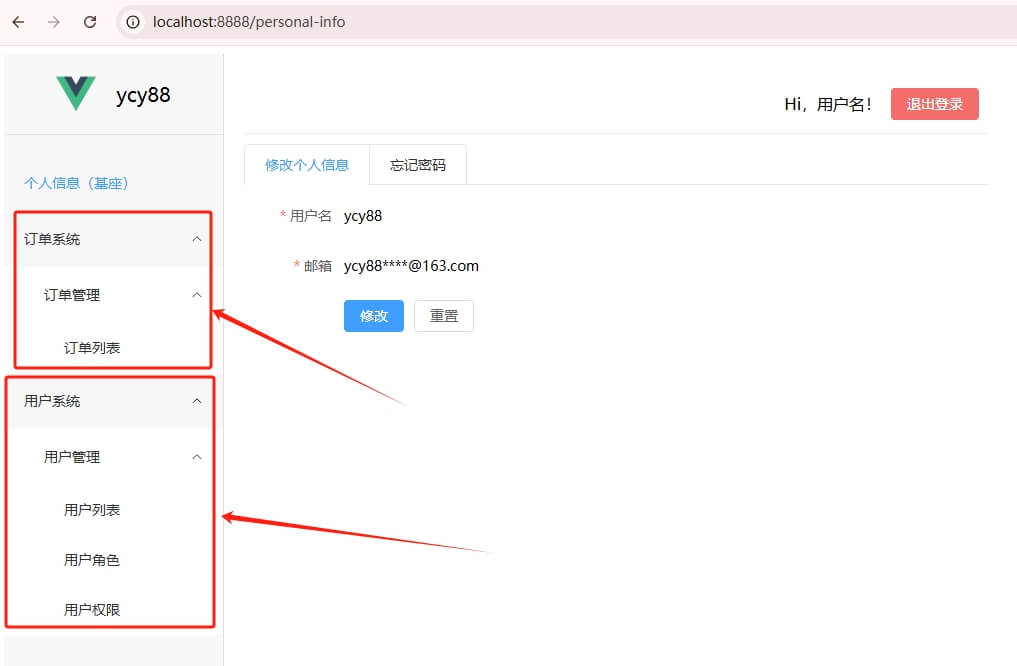
3. 微应用挂载到主应用上的容器:需要区分处理
通过上面的代码,我们可以看到,微应用挂载到主应用上的容器是同一个,即 #Child-box。但是,微应用的路由是不同的,所以我们需要区分处理。否则,会存在 刷新页面一进来,显示空白的情况。
js
container: "#Child-box", // 微应用挂载到主应用上的容器解决方案
userMgt挂载到主应用上的容器是 #Child-box,orderMgt挂载到主应用上的容器是 #Child-box-2。
js
// 其他代码(略)
registerMicroApps(
[
{
name: "userMgt", // 微应用的名称 要求唯一
entry: "//localhost:8081", // 通俗理解就是(微应用的访问地址)
container: "#Child-box", // 微应用挂载到主应用上的容器
activeRule: "/user-mgt", // 微应用激活条件
},
{
name: "orderMgt", // 微应用的名称 要求唯一
entry: "//localhost:8082", // 通俗理解就是(微应用的访问地址)
container: "#Child-box-2", // 微应用挂载到主应用上的容器
activeRule: "/order-mgt", // 微应用激活条件
},
],
{
beforeLoad: (app) => console.log("before load", app.name),
beforeMount: [(app) => console.log("before mount", app.name)],
}
);
// ========================= Start ========================================
// 直接调用 `loadMicroApp` 加载微应用(不激活)
loadMicroApp({
name: "userMgt", // 微应用的名称 要求唯一
entry: "//localhost:8081", // 通俗理解就是(微应用的访问地址)
container: "#Child-box", // 微应用挂载到主应用上的容器
activeRule: "/user-mgt", // 微应用激活条件
props: {
actions,
onRouteReady: (routes) => {
if (!isInit.userMgt) {
isInit.userMgt = true;
stateMenu.menus.push(...routes);
}
},
},
});
loadMicroApp({
name: "orderMgt", // 微应用的名称 要求唯一
entry: "//localhost:8082", // 通俗理解就是(微应用的访问地址)
container: "#Child-box-2", // 微应用挂载到主应用上的容器
activeRule: "/order-mgt", // 微应用激活条件
props: {
actions,
onRouteReady: (routes) => {
if (!isInit.orderMgt) {
isInit.orderMgt = true;
stateMenu.menus.push(...routes);
}
},
},
});这样就能保证无论如何刷新哪个子应用的路由页面,均可以正常显示。
4. 子应用的路由刷新时,如何保证主应用的菜单栏被展开和选中?
vue
<template>
<el-menu
:default-active="activeMenu"
class="el-menu-vertical-demo"
@select="handleSelect"
style="border-right: none !important; background: #f7f7f7 !important"
>
<!-- 其他代码(略) -->
</el-menu>
<!-- 其他代码(略) -->
</template>
<script setup>
import { useRouter } from "vue-router"; // 引入useRouter钩子
import { computed } from "vue";
const router = useRouter(); // 获取router实例
// 动态设置默认选中的菜单项
const activeMenu = computed(() => router.currentRoute.value.path);
// 其他代码(略)
</script>这样,刷新页面,菜单栏的选中状态和展开状态就能正常显示了。
